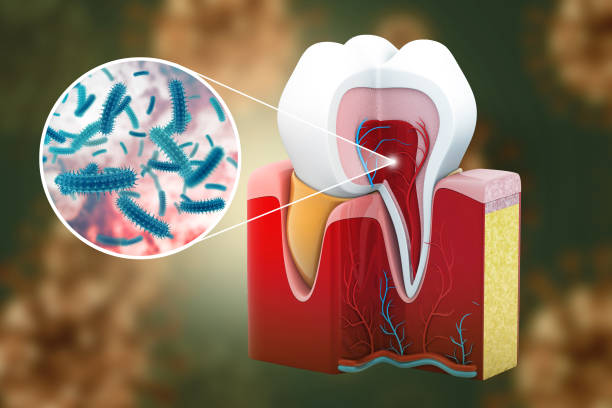Understanding Receding Gums: Causes, Symptoms, and Treatment Options

Understanding Receding Gums: Causes, Symptoms, and Treatment Options
Moderate gum recession presents big threats to your oral health that affect many oral disease patients. The damage to your smile from receding gums also puts your dental health in real danger. Understanding why gum recession happens, plus how to recognize its early stages, will guide you to treatments that protect both your teeth and gums.
What Are Receding Gums?
When your gum tissue wears down, it uncovers more tooth areas and even shows root parts. When teeth movement creates space between teeth and gum base, this lets dangerous bacteria thrive in that area. Uncontrolled receding gums do permanent damage to your tooth root system and lead to tooth loss.
Causes of Receding Gums
Several different circumstances lead to gums moving away from teeth. Here are some of the most common causes:
When you do not brush or floss properly, plaque builds up on your teeth, which creates tartar that damages and pushes back your gums.
- Aggressive Brushing
Brushing too heavily with stiff toothbrushes slowly damages the gum tissue.
- Periodontal Disease
Bacterial infections harm gums through gum disease and push them below the tooth line. The disease attacks both gum tissue and bone support.
- Hormonal Changes
Women with changing hormone levels throughout their menstrual cycle and pregnancy plus menopause become more prone to receding gums.
- Genetics
People who have thin gum tissue in their genes face a greater risk of gum recession.
- Teeth Grinding and Clenching
Continued force on the teeth weakens the gums.
- Tobacco Use
Using tobacco weakens the gum tissue, making it harder for the body to heal itself.
- Poorly Spaced Teeth or Misaligned Alignment
Pushing teeth in improper directions for long periods causes gum tissue to wear back.
Symptoms of Receding Gums
Learning about symptoms of receding gums at the start helps you stop additional damage from occurring. Common signs include:
- Visible Tooth Roots: When gums start to recede, teeth become visible above their normal length.
- Increased Tooth Sensitivity: Pushing hot or icy foods against exposed roots creates a discomfort that intensifies sugar.
- Bleeding Gums: You may bleed when you brush and floss your teeth.
- Red or Swollen Gums: You can spot gum recession through the presence of inflammation.
- Loose Teeth: Your teeth’s foundation can weaken because of gum recession.
- Bad Breath: Bacteria builds up in spaces between teeth and makes bad breath recur.
You need to see a dentist right away when these symptoms appear.
Treatment Options for Receding Gums
Different treatments help treat receding gums. Treatments are picked based on how bad the issue is, plus what makes it happen. Here’s an overview:
1. Improved Oral Hygiene
The right way to brush and floss helps protect your gums from getting worse. Choose soft-bristled toothbrushes when you brush your teeth gently.
2. Scaling and Root Planing
This specialized treatment eliminates plaque and tartar at the base of the gum line while smoothing out tooth roots to help damaged areas heal.
3. Gum Grafting Surgery
Severe receding gums need treatment with a gum graft procedure. To protect your exposed roots, doctors move healthy tissue from your mouth’s different areas or use donated gum samples.
4. Pinhole Surgical Technique (PST)
Through tiny holes in the gum tissue, PST shifts tissue over damaged areas to minimize oral impact.
5. Desensitizing Agents and Fillings
When tooth sensitivity occurs, your dentist will treat exposed roots by applying agents to reduce pain or placing tooth-colored fillings.
6. Orthodontics
Treatment for misaligned teeth and bite problems reduces gum pressure to protect against future recession.
7. Lifestyle Changes
Smokers who learn to manage their stress while using a mouthguard for tooth grinding will see better gum health.
8. Medications
Your dentist may prescribe antibiotics or prescribe special products to fight gum infections while making your gums heal better.
Prevention of Receding Gums
Starting oral care now helps prevent you from losing your gums. Here are some tips to keep your gums healthy:
- Brush your teeth twice every day with a soft-bristled toothbrush.
- Flossing once a day protects your teeth by removing harmful plaque and leftover food between teeth.
- See your dentist on schedule for both cleanings and examinations.
- Avoid any contact with tobacco products.
- The vitamins and minerals you eat nourish your gums.
- See your dentist for a protective mouthguard when you grind or clench your teeth during sleep.
Comparison of Gum Recession Treatment Options
| Treatment Option | Description | Ideal For | Recovery Time |
| Improved Oral Hygiene | Better brushing and flossing techniques to prevent further damage | Mild cases or early-stage gum recession | Immediate |
| Scaling and Root Planing | Deep cleaning below the gum line | Moderate gum recession caused by plaque buildup | A few days |
| Gum Grafting Surgery | Transplanting gum tissue to cover exposed roots | Severe gum recession | 1-2 weeks |
| Pinhole Surgical Technique | Minimally invasive procedure to reposition gum tissue | Moderate to severe cases | 1-2 days |
| Orthodontics | Aligning teeth to reduce pressure on gums | Recession caused by misaligned teeth | Varies |
| Lifestyle Changes | Quitting smoking, reducing stress, and managing teeth grinding | All cases | Depends on habit |
Conclusion
Taking care of your teeth and gums at the earliest stages of receding gum helps you keep them healthy long into the future. Through effective care practices, you can use your knowledge about gum conditions to protect your smile and teeth better. Tend to your gums because they form the base of your overall oral health.
To receive expert dental treatment and unique treatment plans, visit Ramlaoui DDS. Our team works to give you back your oral wellness and self-assurance.

